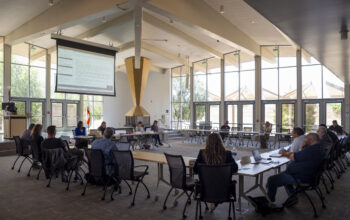She was at a doctor’s appointment 42 miles north of LAX when she found out there had been a shooting. A gunman had killed one person and wounded others, and within five minutes was taken down by an officer. Chaos followed suit from fleeing passengers and airport personnel. She quickly made her way to the airport.
Former LAX Head of Media Relations and LAPD Spokeswoman Mary Grady presented on what crisis communication is on Thursday in Village 8210.
Crisis communications, a subspecialty in public relations, is a career path journalism and public relations students may consider.
Grady recounted her experience and what she learned during the 2013 Los Angeles International Airport Shooting, where Paul Anthony Ciancia opened fire in the airport and killed a TSA officer and injured a few others.
Crisis management is a strategy used by organizations, agencies or companies to protect their reputation when their services are interrupted, according to Grady.
Grady highlighted the importance of learning about crisis management, and why those who are in journalism, media relations or public relations may find it helpful.
“In everybody’s lives, they deal with some type of a crisis and/or are impacted by some type of crisis,” Grady said. “Having a better understanding of how they can handle it themselves and/or respond to a crisis is beneficial information for anybody and everybody.”
Grady mentioned what she hopes the students can take away with them from the presentation.
“The students, whether they are working careers in journalism, public relations or the City of Los Angeles, have a clear understanding of all the different kinds of opportunities,” Grady said. “When you are dealing with something as specific as crisis, what the roles and responsibilities would be for each of those types of positions.”
Film Production major Luis Lindao came to the presentation because he was interested in what was going to be discussed as well as to broaden his knowledge.
“I was not aware of the shooting in 2013,” Lindao said. “I learned how a crisis like that is managed. She was very in depth with the process, the steps taken and the problems you can come across and how to handle them.”
Lindao found it interesting how social media played a role in managing the situation.
“I thought that was an interesting aspect, the importance of using hashtags and using social media to make your status as an official source,” Lindao said. “So that it would not get caught up in other news outlets, rumors and other people’s interpretation of what they understand is happening.”
Grady mentioned that something to learn from the 2013 incident was not using hashtags on Twitter in order to establish the media relations team as the official source for information, so people can have a steady stream of reliable information.
The 2013 LAX shooting was one of the first instances of social media being used during crisis communications. Due to the prevalence of smartphones, there were many people who could be considered citizen journalists who captured what was going on.
Social media is used by crisis management to gain situational awareness, according to Grady.
Journalism, Marketing and TV Cinema major Oscar Silva wanted to learn more about Grady’s profession.
“It makes me understand a little bit more of what I am going to be going through down the line,” Silva said. “There’s a lot to do in her role, like strategizing on the crisis she mentioned. It is very hectic.”
Grady thinks it is important as an organization dealing with a crisis to show empathy and to release information.
“Tell your own bad story yourself,” Grady said.




